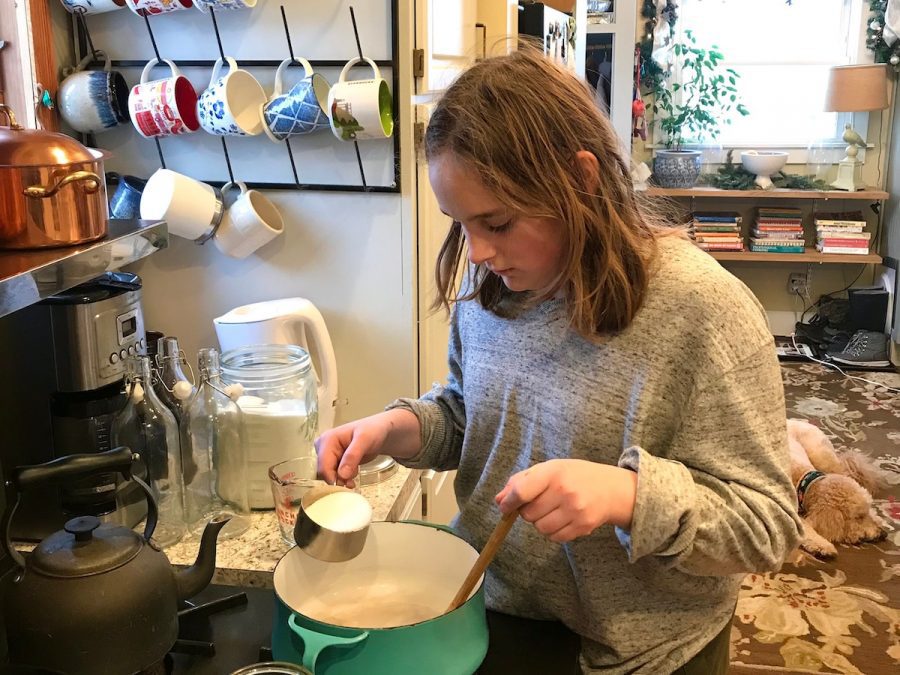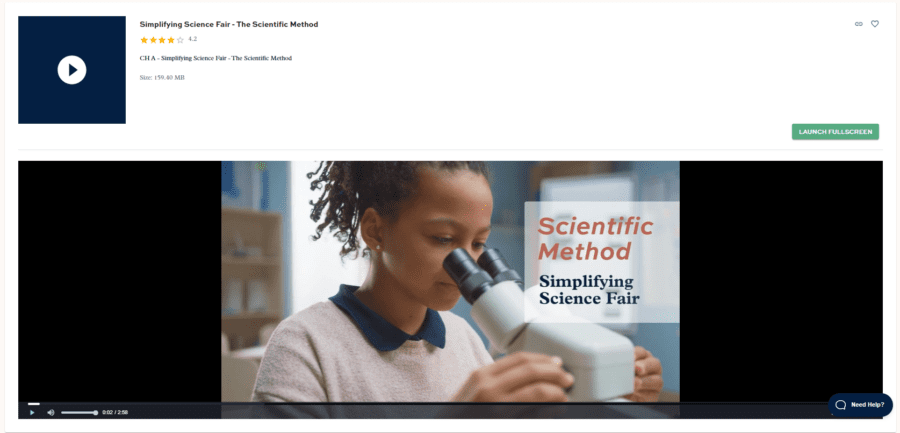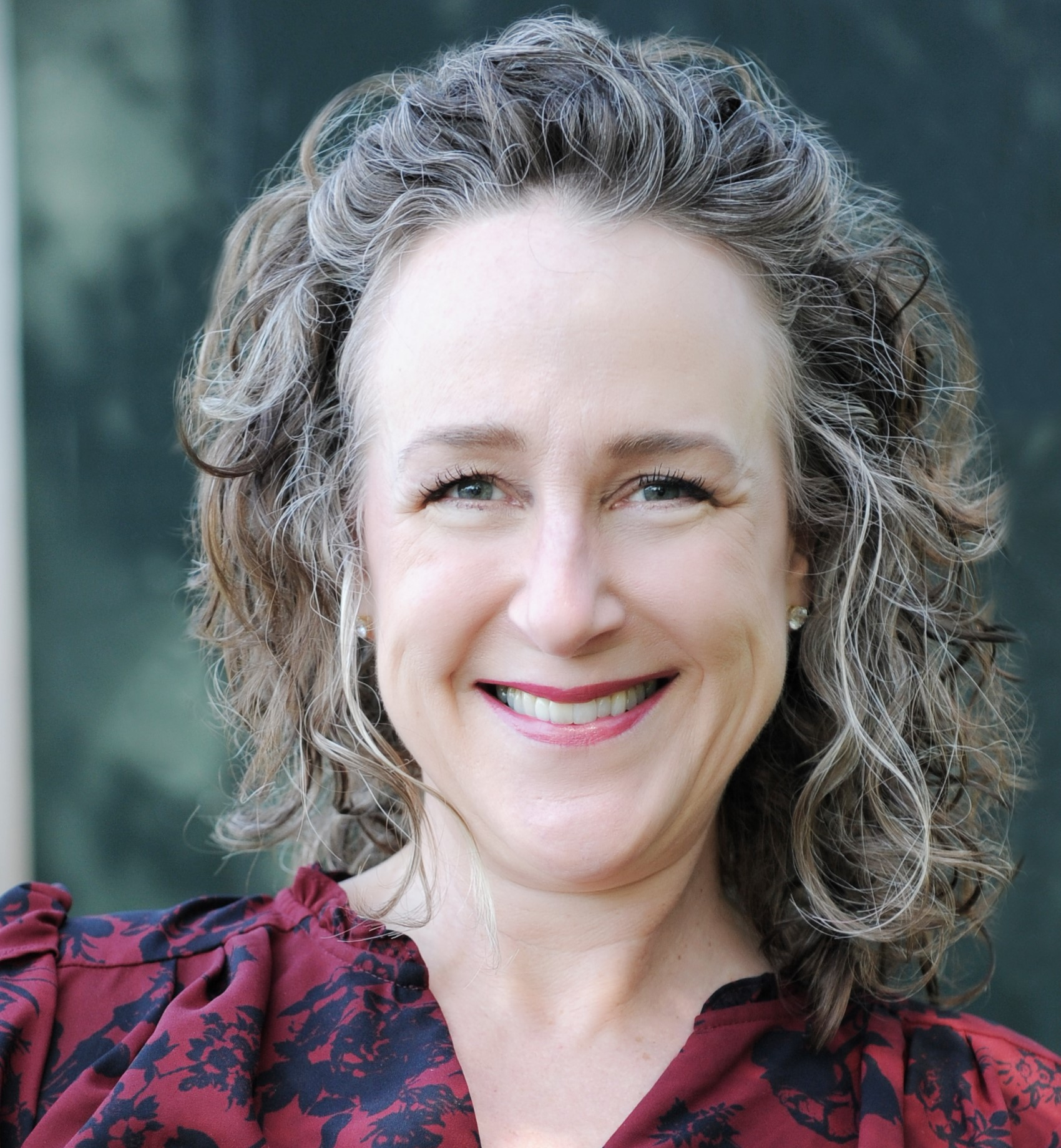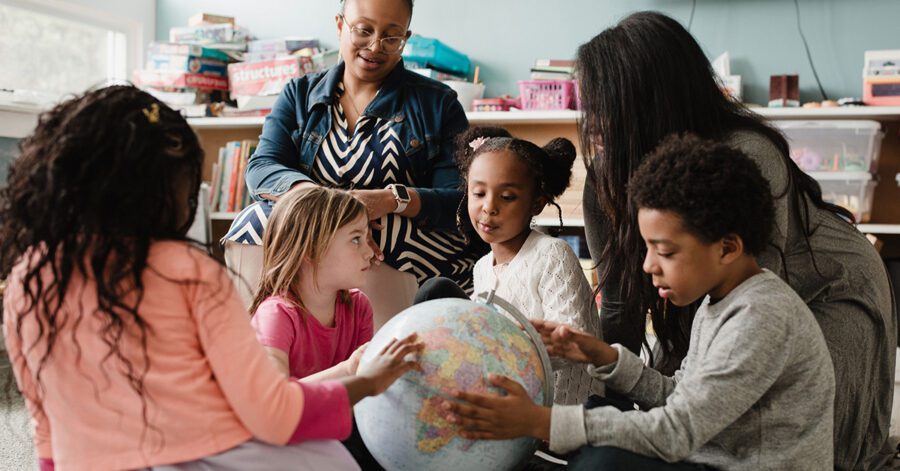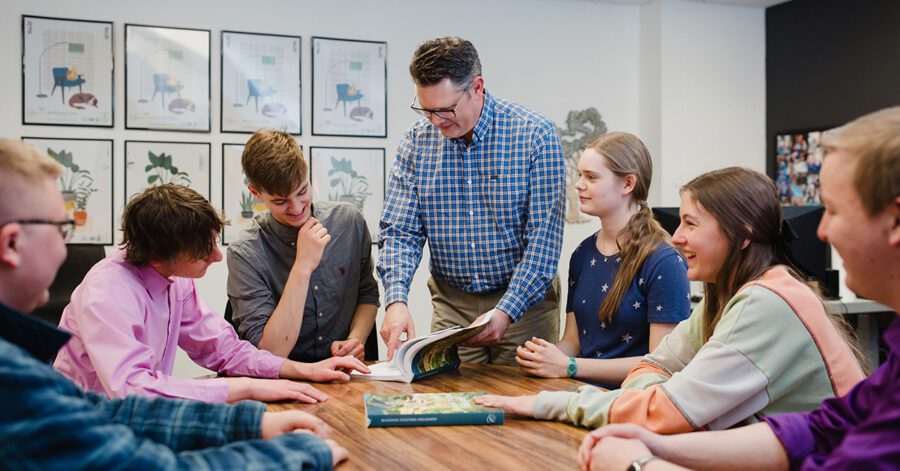The late afternoon sun poured liquid gold through the west-facing windows. A girl, a dog, and a mom stood by the lit stove in a quiet house, methodically adding sugar to water in a pan to create a super-saturated solution. As the steam from the open pan drifted upward, the sun illuminated the molecules and transformed this scene from our homeschool science fair into something extraordinary.
How to Do a Homeschool Science Fair Project
A homeschool science fair is the perfect opportunity to explore the scientific method, encourage creativity, and foster a love for learning. We roughly followed the same steps presented in the Simplifying Science Fair video series available on CC Connected.
Step 0: Develop an Exploratory Question
Do you remember in your child’s early years they would ask delightful and sometimes impossible questions? Why don’t dogs like cats? Will a watermelon grow in my tummy if I swallow a seed? Why can’t I see wind? We are born full of wonder, and the first step of Science Fair is to rekindle wonder. What makes your child curious? What puzzles them? What captures their interest again, again and again? Do they constantly test the material world with “I wonder what will happen if . . . ?” It is in these exploratory questions that the first step lies.
Of course, we can’t allow for infinite wonder, but we do want to encourage our students to be willing to wonder about their topic for at least 10 weeks. In my daughter’s case, she has had an ongoing fascination with crystals since she attended Science Fair in our local homeschooling community when she was yet a wee one! Her project was the perfect application for wonder!
Steps 1–6:
After that initial step of dreaming and of wondering, we roughly followed the same steps outlined in CC Connected (condensing them into a single step in some places):
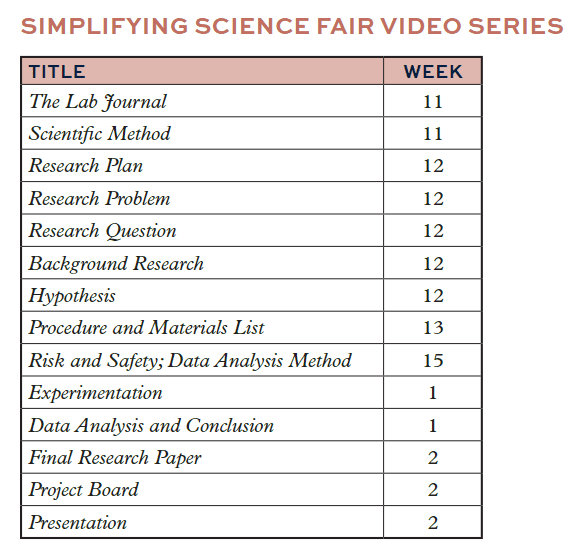
1. The Lab Journal. My daughter prepared a simple, well-organized journal for her science project. She would write everything in a notebook by hand, kept it consistent, and kept it neat.
2. Research. Starting from that place of initial wonderment and guided by the scientific method, my daughter developed a research plan, a research problem, and a research question. Once those were in place, she began her background research. She was interested in crystals, which led her to develop a research plan centered around crystal growth.
3. Hypothesis. A good hypothesis is the starting point for every experiment, and so my daughter spent a lot of time on this particular step.
4. Experimentation. Together, we gathered materials, and she drew up a procedure that included safety precautions (growing crystals involves a lot of heat—always a source of caution for scientific experimentation!) and a plan for analyzing her data. Then, and only then, she did she conduct her experiment.
5. Analysis. My daughter measured her crystal growth, recorded her findings, compared them to her hypothesis, drew up her bibliography, and then wrote her research paper.
6. Presentation. Finally, as we organized the project according to the classical method, my daughter presented her findings using the five canons of rhetoric (more on that in a moment).
A Note on CC Connected and the Challenge A Science Fair
My daughter and I were very well equipped with content in our Challenge A guide and support from our Director. Furthermore, Classical Conversations members have the benefit of wisdom and memory in their local community from parents and students who have done it before. You’ll learn so much from asking questions and having conversations. Further, there’s a wealth of resources in CC Connected including a Parent’s Guide taking you step by step through the experience, videos, and even a certificate of completion to award your student!
Keep in mind that simple is best. It’s not intended to be ironic that 14 of the 17 assets in the Challenge A Learning Center in CC Connected begin with “Simplifying” in their title! There are amazing charts, connections to the Five Common Topics, sample questions, and more.
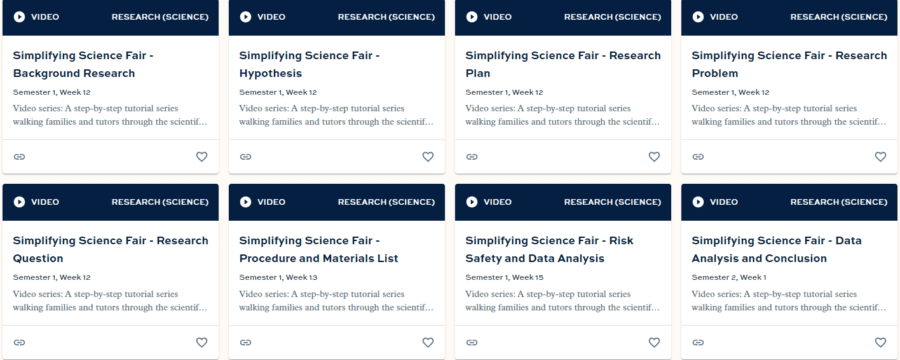
Classical Education and Science Fairs
It is important to note that the classical tools of learning played a vital role in shaping the order of the science fair for my family. We used the Socratic method during the initial stages to spark an ongoing dialogue about crystals, a dialogue that deepened both our understandings. Furthermore, the five canons of rhetoric naturally guided much of our inquiry and activity:
The canon of invention helped us engage some of the big ideas necessary for us to understand the elements of our project and helped us identify the resources we needed.
We used the canon of arrangement to organize our thoughts. My daughter delighted in being wholly responsible for generating her lab notebook, presentation board, and research report. It was necessary to use precise language to describe the process and report findings.
The canon of elocution helped my daughter articulate her thinking and conclusions well.
The canon of memory required attention and practice as my daughter had many big words to learn to pronounce correctly, some detailed technical information to share, and an involved process to explain.
And finally, this all came together in the canon of delivery as my daughter stood before judges, shared her abstract, detailed her process, shared her conclusions, and, of course, offered them some sugar crystal candy!
What Do Homeschoolers Learn From Science Fairs?
Sure, we were “just” following the scientific method as we conducted my daughter’s Challenge A science fair experiment. But, in the quietness of that moment, my eyes were opened to see more than an assignment. I saw ownership, order, and an expression of wonder and delight as my daughter interacted with her physical world.
Science Fairs Encourage Students to Take Ownership
From the beginning of her Challenge A experience, my daughter had an unwavering desire to grow sugar and borax crystals and develop an experiment for science fair that would allow her to test a dependent variable. She enthusiastically watched YouTube videos, one after the other, of different (but remarkably similar) ways to grow crystals. She talked about crystals, made shopping lists for supplies to grow crystals, set out rows of food coloring drops to make psychedelic crystals, and created a plan for producing and then presenting her classmates with edible crystals as part of her science fair presentation. She read her Challenge A guide faithfully, followed the weekly assignments, and utilized the feedback and support her Challenge A Director offered. She was on top of it, ready to go, eager to get started.
And then she hit a roadblock.
She had not designed a good experiment. Although there are plenty of resources for planning and executing a crystal-growing science fair project with good experiments, she had discounted any need for outside input. “I’ve got this mom!” she told me, all about the science and blissfully confident in the process. And it was when she bumped into herself and her unaccounted-for barriers that her ownership of her science fair project began to soar.
Back to research and YouTube, she went! A review of her notes from Challenge A seminar, her guide, and her Director’s feedback were in order. She asked lots of questions, employed dialectic skills through the five common topics, and reset her course. She had a new hypothesis, a new experiment, and a measurable dependent variable for which she could expect satisfactory results.
She did it! Without too much drama and with steadfastness, she kept hold of science fair as her project. Mom wasn’t there to “bail her out.” Instead, I supported her steps. I let her hold the responsibility and discomfort of her initial mistakes. And, as I let her endure this modest failure, she overcame her frustrations, renewed her efforts toward a project she still loved, and took hold of her experience and bore up under its requirements. Indeed, the theme of Challenge A, “Attention Leads to Ownership,” rings true!
Science Fairs Show Students Order
Science fair in Challenge A is beautifully planned. There’s nothing left to chance, guesswork, or up to the parent or student to invent. The Challenge A guide does a commendable job of moving your student along weekly. Its appendices are the perfect balance of supplemental information. Equipping and encouragement are available on CC Connected. And your Challenge A Director is sincerely interested in your student’s project and is a wealth of support and motivation!
It’s probably not fair to say that science fair is easy. There is quite a bit of work involved, and sometimes the “extra” elements may catch you off guard. For example, I hadn’t understood just how much sugar my daughter would need to complete her crystals, nor did I anticipate the totality of what she hoped to gift her classmates! But, on the flip side, it’s probably not accurate to say that science fair is difficult. It falls somewhere in the middle. And, in the scope and sequence of the Challenge years, Challenge A is its “sweet spot”!
There are character issues that come up. Ordering one’s time, following instructions, responding appropriately to authority, following through — all these and more will be a part of the science fair experience. And I would not be honest if I didn’t disclose that there were indeed times when the disorder of my mind or my daughter’s attitude was evident. But it was our behavior in the difficulties that arose which allowed us to break through, reorder our efforts, and move forward. We returned to order, and our path grew smooth.
Science Fairs Allow Students to Wonder and Delight
My daughter never grew tired of growing crystals. Instead, she delighted in each new batch as if it were the first time she’d ever seen such a thing. She held regular science fair chats with her dog, believing all along that Primrose (her pet) was equally interested in the unique formations growing on our kitchen counter. She acted as if she was the first human being to understand sugar crystals because, in a way, it’s as if she was the first—because it was her discovery!
In A Different Kind of Teacher: Solving the Crisis of American Schooling, John Taylor Gotto says, “The primary goal of real education is not to deliver facts but to guide students in the truths that will allow them to take responsibility for their lives.”
This is the beauty of the science fair. My daughter encountered truths about her physical world, herself and her capacities, and how to take responsibility for an extended project. In a small and impactful way, she took responsibility for her life in active participation in science fair.

What is the Challenge A Science Fair?
I’m not incredible at remembering to take pictures, but we took some that golden afternoon. The light was so intense you can see individual steam droplets rising in the photos. My daughter stands confidently in front of the range, her dog obediently at her feet, and my daughter’s face is composed; her eyes sparkle, and it is evident that she was experiencing the harmony of the ages as she quietly stirred.
After all was said and done and the project board tucked away for memory’s sake, I was asked to write my response to the question, “What is the Challenge A science fair?” Now, I could offer academic, philosophical, or characterological answers. Still, they wouldn’t ring as true as this: science fair, in our particular case, is a gift. It is an unanticipated joy. And, it now remains a precious memory of a specific afternoon, a successful project, and the treasures of ownership, order, wonder, and delight.

